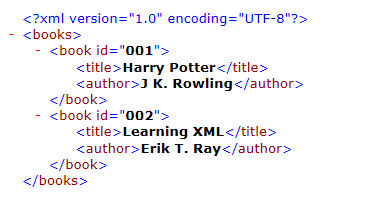Using dom4j to parse xml in java (sample code)
Although there are two standard parsing methods, Dom and Sax, in Java
, they are not easy to operate. For a beginner like me, some of the codes are disgusting.
To this end, great third-party development groups have developed tools such as Jdom and Dom4j
In view of the current trend, we will talk about the basic usage of Dom4j here, without involving complex operations such as recursion
Dom4j has many uses, and the examples on the official website are a bit obscure, so I won’t go into them here
First we need to create an xml document, and then we can parse it
xml document:
<?xml version="1.0" encoding="UTF-8"?>
<books>
<book id="001">
<title>Harry Potter</title>
<author>J K. Rowling</author>
</book>
<book id="002">
<title>Learning XML</title>
<author>Erik T. Ray</author>
</book>
</books>Example 1: Use List to parse xml
import java.io.File;
import java.util.List;
import org.dom4j.Attribute;
import org.dom4j.Document;
import org.dom4j.Element;
import org.dom4j.io.SAXReader;
public class Demo {
public static void main(String[] args) throws Exception {
SAXReader reader = new SAXReader();
File file = new File("books.xml");
Document document = reader.read(file);
Element root = document.getRootElement();
List<Element> childElements = root.elements();
for (Element child : childElements) {
//未知属性名情况下
/*List<Attribute> attributeList = child.attributes();
for (Attribute attr : attributeList) {
System.out.println(attr.getName() + ": " + attr.getValue());
}*/
//已知属性名情况下
System.out.println("id: " + child.attributeValue("id"));
//未知子元素名情况下
/*List<Element> elementList = child.elements();
for (Element ele : elementList) {
System.out.println(ele.getName() + ": " + ele.getText());
}
System.out.println();*/
//已知子元素名的情况下
System.out.println("title" + child.elementText("title"));
System.out.println("author" + child.elementText("author"));
//这行是为了格式化美观而存在
System.out.println();
}
}
}Example 2: Use Iterator to parse xml
import java.io.File;
import java.util.Iterator;
import org.dom4j.Attribute;
import org.dom4j.Document;
import org.dom4j.Element;
import org.dom4j.io.SAXReader;
public class Demo {
public static void main(String[] args) throws Exception {
SAXReader reader = new SAXReader();
Document document = reader.read(new File("books.xml"));
Element root = document.getRootElement();
Iterator it = root.elementIterator();
while (it.hasNext()) {
Element element = (Element) it.next();
//未知属性名称情况下
/*Iterator attrIt = element.attributeIterator();
while (attrIt.hasNext()) {
Attribute a = (Attribute) attrIt.next();
System.out.println(a.getValue());
}*/
//已知属性名称情况下
System.out.println("id: " + element.attributeValue("id"));
//未知元素名情况下
/*Iterator eleIt = element.elementIterator();
while (eleIt.hasNext()) {
Element e = (Element) eleIt.next();
System.out.println(e.getName() + ": " + e.getText());
}
System.out.println();*/
//已知元素名情况下
System.out.println("title: " + element.elementText("title"));
System.out.println("author: " + element.elementText("author"));
System.out.println();
}
}
}Running results:

Example 3: Create xml document and output to file
import java.io.File;
import java.io.FileOutputStream;
import org.dom4j.Document;
import org.dom4j.DocumentHelper;
import org.dom4j.Element;
import org.dom4j.io.OutputFormat;
import org.dom4j.io.XMLWriter;
public class Demo {
public static void main(String[] args) throws Exception {
Document doc = DocumentHelper.createDocument();
//增加根节点
Element books = doc.addElement("books");
//增加子元素
Element book1 = books.addElement("book");
Element title1 = book1.addElement("title");
Element author1 = book1.addElement("author");
Element book2 = books.addElement("book");
Element title2 = book2.addElement("title");
Element author2 = book2.addElement("author");
//为子节点添加属性
book1.addAttribute("id", "001");
//为元素添加内容
title1.setText("Harry Potter");
author1.setText("J K. Rowling");
book2.addAttribute("id", "002");
title2.setText("Learning XML");
author2.setText("Erik T. Ray");
//实例化输出格式对象
OutputFormat format = OutputFormat.createPrettyPrint();
//设置输出编码
format.setEncoding("UTF-8");
//创建需要写入的File对象
File file = new File("D:" + File.separator + "books.xml");
//生成XMLWriter对象,构造函数中的参数为需要输出的文件流和格式
XMLWriter writer = new XMLWriter(new FileOutputStream(file), format);
//开始写入,write方法中包含上面创建的Document对象
writer.write(doc);
}
}Run result:

For more articles related to using dom4j to parse xml in java (sample code), please pay attention to the PHP Chinese website!

Hot AI Tools

Undresser.AI Undress
AI-powered app for creating realistic nude photos

AI Clothes Remover
Online AI tool for removing clothes from photos.

Undress AI Tool
Undress images for free

Clothoff.io
AI clothes remover

AI Hentai Generator
Generate AI Hentai for free.

Hot Article

Hot Tools

Notepad++7.3.1
Easy-to-use and free code editor

SublimeText3 Chinese version
Chinese version, very easy to use

Zend Studio 13.0.1
Powerful PHP integrated development environment

Dreamweaver CS6
Visual web development tools

SublimeText3 Mac version
God-level code editing software (SublimeText3)

Hot Topics
 1378
1378
 52
52
 Is the conversion speed fast when converting XML to PDF on mobile phone?
Apr 02, 2025 pm 10:09 PM
Is the conversion speed fast when converting XML to PDF on mobile phone?
Apr 02, 2025 pm 10:09 PM
The speed of mobile XML to PDF depends on the following factors: the complexity of XML structure. Mobile hardware configuration conversion method (library, algorithm) code quality optimization methods (select efficient libraries, optimize algorithms, cache data, and utilize multi-threading). Overall, there is no absolute answer and it needs to be optimized according to the specific situation.
 How to convert XML files to PDF on your phone?
Apr 02, 2025 pm 10:12 PM
How to convert XML files to PDF on your phone?
Apr 02, 2025 pm 10:12 PM
It is impossible to complete XML to PDF conversion directly on your phone with a single application. It is necessary to use cloud services, which can be achieved through two steps: 1. Convert XML to PDF in the cloud, 2. Access or download the converted PDF file on the mobile phone.
 How to convert XML to PDF on your phone?
Apr 02, 2025 pm 10:18 PM
How to convert XML to PDF on your phone?
Apr 02, 2025 pm 10:18 PM
It is not easy to convert XML to PDF directly on your phone, but it can be achieved with the help of cloud services. It is recommended to use a lightweight mobile app to upload XML files and receive generated PDFs, and convert them with cloud APIs. Cloud APIs use serverless computing services, and choosing the right platform is crucial. Complexity, error handling, security, and optimization strategies need to be considered when handling XML parsing and PDF generation. The entire process requires the front-end app and the back-end API to work together, and it requires some understanding of a variety of technologies.
 How to open web.xml
Apr 03, 2025 am 06:51 AM
How to open web.xml
Apr 03, 2025 am 06:51 AM
To open a web.xml file, you can use the following methods: Use a text editor (such as Notepad or TextEdit) to edit commands using an integrated development environment (such as Eclipse or NetBeans) (Windows: notepad web.xml; Mac/Linux: open -a TextEdit web.xml)
 Recommended XML formatting tool
Apr 02, 2025 pm 09:03 PM
Recommended XML formatting tool
Apr 02, 2025 pm 09:03 PM
XML formatting tools can type code according to rules to improve readability and understanding. When selecting a tool, pay attention to customization capabilities, handling of special circumstances, performance and ease of use. Commonly used tool types include online tools, IDE plug-ins, and command-line tools.
 Is there any mobile app that can convert XML into PDF?
Apr 02, 2025 pm 08:54 PM
Is there any mobile app that can convert XML into PDF?
Apr 02, 2025 pm 08:54 PM
An application that converts XML directly to PDF cannot be found because they are two fundamentally different formats. XML is used to store data, while PDF is used to display documents. To complete the transformation, you can use programming languages and libraries such as Python and ReportLab to parse XML data and generate PDF documents.
 How to open xml format
Apr 02, 2025 pm 09:00 PM
How to open xml format
Apr 02, 2025 pm 09:00 PM
Use most text editors to open XML files; if you need a more intuitive tree display, you can use an XML editor, such as Oxygen XML Editor or XMLSpy; if you process XML data in a program, you need to use a programming language (such as Python) and XML libraries (such as xml.etree.ElementTree) to parse.
 xml online formatting
Apr 02, 2025 pm 10:06 PM
xml online formatting
Apr 02, 2025 pm 10:06 PM
XML Online Format Tools automatically organizes messy XML code into easy-to-read and maintain formats. By parsing the syntax tree of XML and applying formatting rules, these tools optimize the structure of the code, enhancing its maintainability and teamwork efficiency.




